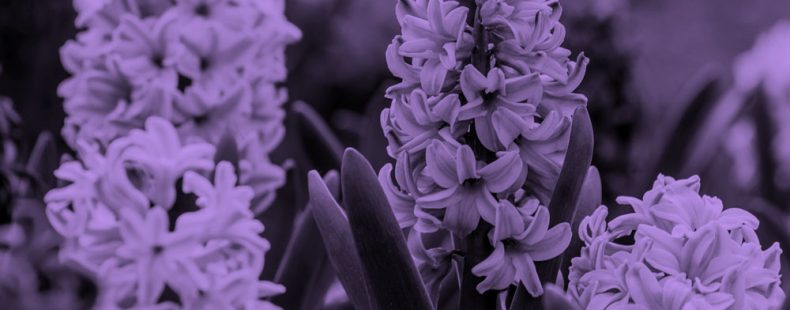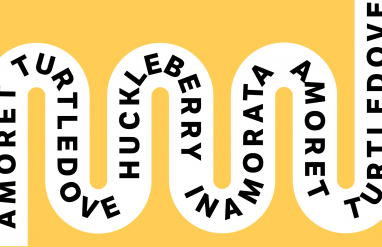When you hear the word purple, what pops into your head? Chances are it’s one of a huge number of different shades, ranging from pale lavender to deep burgundy. There are so many different colors that fall under the vast umbrella of purple, so when you’re writing or talking about something in the shade, it’s helpful to be a bit more specific. Shades of purple can be found on everything from fruit to plants to wild animals. Here are 15 unique and vibrant words you can use when talking about the color purple.
lilac
Lilac is a “pale, reddish purple” that might call to mind a stroll through a garden. The color is named for the purplish flowers that grow on the shrub of the same name. This pale violet color is at home in a spring scene or even in the color palette of a sunrise. First recorded in the early 1600s, the word lilac comes from the Persian līlak, meaning “bluish.”
plum
If you need a darker shade of purple, plum will do. Plum is “a deep purple varying from bluish to reddish.” Like many words on the list, plum gets its name from something in nature. In this case, it’s the fruit that grows on plum trees. It can be traced to the Greek proúmnē, or “plum tree,” and it has been in use in English since at least the 900s.
violaceous
Is it purple or is it violaceous? This adjective means “of a violet color; bluish-purple.” It’s a perfect descriptor for anything with purplish hues, from fruit to flowers to the looming mountains in the distance. Violaceous is related to violet and was first recorded in English in the mid-1600s.
magenta
Magenta is a “purplish red.” It’s also the name of a town in Italy where the French and Sardinians defeated Austrian troops in 1859. The color was named for this battle site, as the famous fight took place shortly before magenta dye was discovered. But why was the town called Magenta? The town’s name may trace back to the Roman emperor Marcus Aurelius Valerius Maxentius, who is believed to have had a headquarters there.
amethyst
Some shades of purple really shine. Amethyst is “a purplish tint,” consistent with the purple or violet color of a type of quartz that shares the same name. It has a surprising backstory. Though the word has been in use in English since the mid-1200s, it has roots in the Greek améthystos, meaning “not intoxicating, not intoxicated.” This is because it was once believed the stone amethyst could prevent intoxication.
Learn more about the stone amethyst and other birthstones that make every month sparkle.
amaranthine
If you’re describing a red wine or something else that’s “of purplish-red color,” consider amaranthine. Amaranthine is the color of amaranth, a flowering plant known for its striking foliage or flower clusters. Amaranth comes from the Latin amarantus, an alteration of the Greek amáranton, meaning “unfading flower.”
periwinkle
Is it blue or is it purple? If it’s periwinkle, it must be somewhere in between. Periwinkle means “a blue-violet color,” and it’s associated with myrtle, a trailing plant with evergreen foliage and blue-violet flowers. Periwinkle is a common color used on furniture or clothing. The word has been in use in English since before the year 1500.
grape
If you asked someone to name something purple, a grape would probably come to mind. Because of the appearance of the fruit, grape has also come to mean “a dull, dark purplish-red color.” When something is grape, it has the flat, muted shade we associate with grapes, and it may range from a very deep purple to one with shades of pink or red. Grape comes from Middle English and was first recorded in the early 1200s.
lavender
While the plant lavender is well known for its scent, it has also influenced the name of a well-known shade of purple. Lavender, as a color, is “a pale bluish purple.” It’s a popular choice for weddings. There’s even lavender ice cream! Lavender comes from the Medieval Latin lavendula, meaning “a plant livid in color.”
wine
Wine isn’t just a drink you have with dinner. It’s also “a dark reddish color, as of red wines.” Wine might describe the particular shade of purple you want to paint your kitchen or the pretty new lipstick that’s on sale at the cosmetics store. While wine certainly indicates a deep purple-red color, you could be even more specific by naming a certain type of wine. For example, burgundy can be used to mean a “grayish red-brown to dark blackish-purple.”
Learn the words to use to sound like a wine expert.
violet
As a flower, violets are known for their vibrant purple color. That’s why the “reddish-blue” color of the same name is called violet. Violet exists at the opposite end of the visible spectrum from red. You probably recognize it as the “V” in the abbreviation ROYGBIV, the colors of the rainbow. Typically, violet is more red in hue than a standard purple, like the color of the sky at sunset or the feathers of a Violet-backed starling.
pomegranate
Much like the fruit, pomegranate is a deep reddish or pinkish-purple color. Because of its complexity, it’s a great color for decorating. Pomegranate has been in use in English since at least the late 1200s, and it has a pretty straightforward origin. The name for the many-seeded fruit comes from the Medieval Latin pomum granatum, which literally means “a seedy apple.”
heliotrope
For a lighter shade of purple, give heliotrope a try. It’s “a light tint of purple; reddish lavender.” Not only is this word fun to say, but it also has a cool backstory. Like other purple shades, the color heliotrope shares its name with a plant. Helios is Greek for “sun,” while the Greek trópos means “a turn, change.” The plant heliotrope was named for the way its flowers and leaves turn towards the sun.
orchid
The word orchid calls to mind the delicate flowers of an orchid plant, which are sometimes a light “bluish to reddish purple color.” You can use orchid to talk about light shades of purple that fall somewhere between lilac and lavender. Orchid entered English in 1845 in the third edition of School Botany by John Lindley, and you might be surprised by its origins. This plant-name-turned-color can be traced to the Greek órchis, meaning “testicle.”
perse
Perse means “of a very deep shade of blue or purple.” You might use perse to describe fabric or pigments that are a deep indigo or even purple with hints of black. Though a less common term for purple, the word has been in use in English since the 1300s. It comes from the Middle English pers, perhaps a variant of the Medieval Latin persus, a kind of blue.
Love these colors? Then take the quiz!
If this list has inspired you to make your own bouquet out of purple vocabulary, then you can review them as a collection any time you want with our purple synonyms word list. Or, give your colorful knowledge a challenge by going straight to our positively pleasant purple synonyms quiz.













